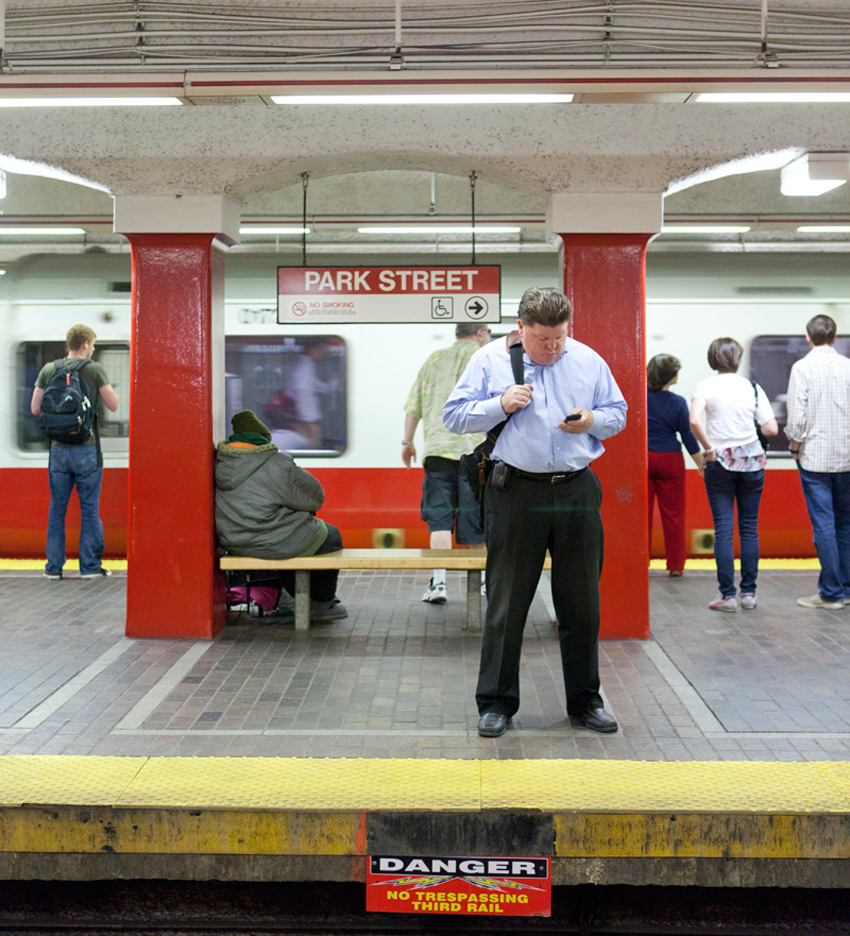Flight or Fight: Why Do People Film Fights on the MBTA Instead of Stopping Them?
The Bystander Effect, where people witness an emergency idly rather than intervene to help a stranger, has been documented for decades. But a modern form of this phenomenon—where bystanders pull out their smartphones to record such confrontations—has been evidenced all over the country and, recently, in Boston.
Following St. Patrick’s Day, a couple of videos showing people being attacked on the MBTA after riders became embroiled in heated arguments popped up online. In one video, a female repeatedly punches a male passenger in the face, as the people sitting nearby do nothing, and eventually get up and walk away from the scene. The person recording the video remains away from the conflict, and can be heard laughing.
In another unrelated incident, a Reddit user describes how a coworker was assaulted after trying to diffuse an encounter on the T. According to the post’s author, a friend was attacked on the MBTA after trying to stop two men who were allegedly “dragging” a female by her arms at the Downtown Crossing station. “When my coworker stepped in to say something she was verbally assaulted and subsequently physically,” the author writes.
While the author’s friend tried to help, much like the attack on St. Patrick’s Day, others just stood by and recorded the scene. The post’s author makes a plea to the Internet to help locate the “people who recorded it on their phone …” to find the videos to use as evidence of the assault.
According to Dr. Todd Farchione, a clinical psychologist and assistant research professor at Boston University’s Center for Anxiety and Related Disorders, people often don’t get involved in these types of brawls and fisticuffs, like the one recorded on St. Patrick’s Day, because of the fear of being hurt themselves, a notion that correlates with the long-studied Bystander Effect.
“With fights, there is the actual threat there, so people don’t want to get involved and don’t want to get harmed being part of that altercation,” Farchione says. “I have seen these types of things where people are yelling—a father really yelling at his son—and the question becomes do we step in? I think, socially, we are taught not to butt into other peoples’ business.”
Farchione adds that, in other dilemmas along the transit lines—like when people have fallen onto the tracks—bystanders have been quick to help out.
MBTA officials did not return several e-mails asking what passengers should do if they witness an assault, but the T’s website does offer tips to riders about how to handle confrontations and stay safe. MBTA Transit Police also released a mobile reporting option called the “See/Say” app in 2012, which lets riders snap photos of situations along the subway lines and quickly report them to officials.
There are ways to avoid stepping in and stopping a fight while remaining vigilant, like using the See/Say smartphone app, but Farchione says, in a time where everyone has immediate access to phones and social media sites, there can be a feeling of reward associated with filming a potentially dangerous situation rather which keeps people from intervening.
“We tend to get reinforced for [recording fights]. It can show up on the news, or get a million hits on YouTube, and that’s what is getting reinforced,” he says. “To me … if you have time to pull out a camera and film someone getting into a fight, you would think if you can do that, you should be using that energy to help the person and alert the police.”
But Farchione’s hope that people would drop the camera and take action doesn’t usually occur. It’s hard to know who has a weapon, or who might retaliate during the intervention, he says. “What it comes down to is why would someone want to risk their own lives if it’s not of their own making.”
As the woman at Downtown Crossing found out, certain risks are involved, which is why Farchione said people often flee, or just stand by, film, and never get involved. “You want to be the hero, but at the same time there is that potential cost, and often times, I think people are trying to weigh that,” he says.



